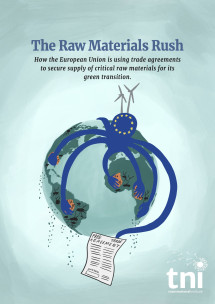The Raw Materials Rush How the European Union is using trade agreements to secure supply of critical raw materials for its green transition
While the EU is committed to net-zero emissions, the prevailing approach hinges on maintaining capitalist expansion, raising questions about the viability of a true green transition. The endeavor faces complexities, notably in the context of global competition and the imperative to secure essential raw materials, emphasizing extractive production models.

Downloads
Authors
Introduction
‘We must move at warp speed. We don’t have a moment to lose. We must super-charge our efforts. The climate time-bomb is ticking.
-United Nations Secretary-General António Guterres at the launch of the 2023 Intergovernmental Panel on Climate Change’s (IPCC) AR6 Synthesis Report: Climate Change 20231
Climate change is a reality, and it is now widely accepted that the burning of fossil fuels massively contributed to global warming. A major survey that the United Nations Development Programme (UNDP) commissioned in 2020 found that 72% of Western Europeans and North Americans realise that we are living in a climate emergency. In her opening speech at the Beyond Growth conference held in Brussels in May 2023, the president of the European Commission, Ursula von der Leyen, stated: ‘An economic growth model centred on fossil fuels is simply obsolete. [...] We need to decarbonize our economies as quickly as possible’.
By the end of November 2022, 87 countries had announced pledges to reduce emissions to net zero within this century. Together, these countries account for over 85% of global emissions. In most cases, however, these pledges and their associated predictions are based on the assumption that energy consumption and use will grow significantly in the high- income countries, in line with continued capitalist expansion. The plans to achieve net zero emissions by 2050 while maintaining the current model of economic growth depend on transforming economies and industries based on fossil fuels to being powered by so-called clean technologies. Consequently, it is estimated that the production of e-vehicles could increase 15-fold by 2050, and that the use of renewables such as solar panels and wind turbines might potentially quadruple.
This process is being framed as a ‘green transition’. Although the implementation of renewable energy systems and e-vehicles started at least 20 years ago, it is now going full-steam ahead. There are several reasons for this. The first is the overall acceptance that climate change is a major threat to the survival of humanity on this planet. The second is the need to resolve the very low growth rate of the so-called mature capitalist economies, with some even having entered recession, such as Germany, coupled with low private investment rates due to an increasing number of armed conflicts and geopolitical tensions, among other reasons. The need to convert fossil-fuel-based capitalism to its greened version for the ‘sake of saving humanity from climate disaster’ is used to justify major flows of public spending, credit guarantees as well as other incentives and benefits for private companies which are regarded as fundamental drivers of the ‘green transition’. Yet, despite its framing, the language of green transition is also being used to hide and ‘greenwash’ intensified militarism, including on Europe’s borders, with so called critical 'green' raw materials ending up servicing the needs of the booming arms and security industry.
At the same time, neither the structure of the capitalist system and its modes of production and consumption – the root causes of today’s multiple crises – nor the recipients of extensive fiscal support, are being questioned. Rather, the major economic powers, especially China, the USA and the EU are engaged in fierce competition to take the lead in this transition process, with specific support programmes and subsidies for their own national industrial sectors. The EU Commission, for example, has presented its European Green Deal, an initiative comprising dozens of measures to ‘green’ the European economy and make the EU climate-neutral by 2050. One of these is the Green Deal Industrial Plan (GDIP) which was launched in February 2023 and envisages major financial support and incentives for investments in cleaner technologies. The USA, with its Inflation Reduction Act (IRA) and China with its Made in China 2025 have launched their own ambitious subsidy programmes to accelerate the transformation of domestic industries and economies and to keep as many processing steps as possible in their own countries.
The weak spot of these initiatives is the access to the necessary primary raw materials and metals to transform the power base of these economies. This is especially true for the EU, which is already consuming 25–33% of metals produced globally with just 6% of the world’s population. In addition, for most metals the EU is between 75% and 100% dependent on imports, most of which come from China or countries in the global South.





